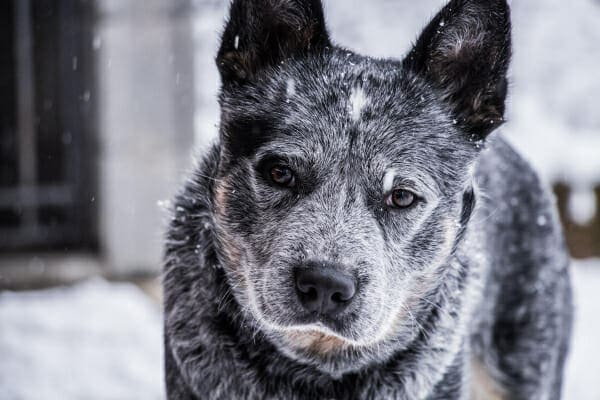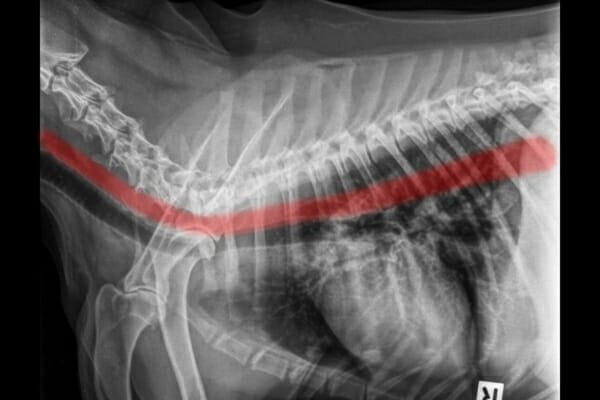Megaesophagus in dogs, a condition where the esophagus becomes dilated and functions poorly, can be an overwhelming and concerning diagnosis for many dog parents. But help is here. Integrative veterinarian Dr. Julie Buzby explains the causes, symptoms, diagnosis, treatment, and prognosis for megaesophagus so you can be prepared should your dog develop this condition.

A 7-year-old German Shepherd dog, Jasper, sat patiently during his examination. I listened carefully as his mom explained that he’d been bringing up all of his food immediately after eating. She mentioned she had tried all kinds of different flavors of dog food in hope that he had developed a food allergy. However, nothing was working. The only thing that her dog could hold down was water.
My veterinary client was so worried about her beloved dog. It was clear to her that he was losing weight and seemed less energetic. And she wondered what it meant for his future if her dear dog couldn’t keep any food in his stomach.
As Jasper’s mom was telling me what was going on at home, I had a strong suspicion about what could be wrong. I explained to her that based on her dog’s symptoms, I suspected he had a condition called acquired megaesophagus.
- What is megaesophagus in dogs?
- How a dog's esophagus works and why it may weaken resulting in megaesophagus
- Regurgitation is one of the first signs of megaesophagus
- What are the types of megaesophagus in dogs?
- What are the causes of megaesophagus in dogs?
- What are the symptoms of megaesophagus in dogs?
- How is megaesophagus diagnosed?
- What is the treatment for megaesophagus?
- What is the prognosis for a dog with megaesophagus?
- A Bailey Chair for Jasper the German Shepherd
- Managing megaesophagus in partnership with your vet
- Have you ever had a dog with megaesophagus?
What is megaesophagus in dogs?
Megaesophagus in dogs is a condition where a dog’s esophagus becomes enlarged (specifically, larger in diameter) and weakened. Since the esophagus is the pathway for food to travel from mouth to the stomach, megaesophagus prevents food from efficiently moving down the esophagus and into the stomach. As a result, food gets stuck in the esophagus.
I like to imagine it this way. Think about one leg of a brand new pair of pantyhose. It’s tight and small, right? Now think about one leg of a stretched out pair of pantyhose. Instead of being tight, it’s big and floppy. That’s what a megaesophagus is like. Rather than being strong and narrow, the esophagus is weak and stretched out, and not all that good at its job.
Continuing with the pantyhose analogy, a dog’s esophagus doesn’t start out flaccid. Something happens to disrupt the normal function of the esophagus and create a megaesophagus.
To understand, let’s take a closer look at how the esophagus should work and how esophageal function changes in megaesophagus.
How a dog’s esophagus works and why it may weaken resulting in megaesophagus
When your dog eats, food must travel from the mouth to the stomach somehow. This is where the esophagus comes in. This muscular tube is located in the dog’s neck and connects the mouth to the stomach.
Moving food from the mouth to the stomach is a very active process that involves multiple muscles and nerves. Once a dog swallows the food, it moves into the top of the esophagus. Then the muscles and nerves work together to cause the esophagus to constrict and relax. This peristaltic action pushes the food down the esophagus and into the stomach.
However, if the nerves aren’t telling the esophagus to contract correctly or the food physically can’t get through an abnormally narrow part of the esophagus (e.g. a stricture), the esophagus starts to malfunction. As a result, the esophagus becomes wider in diameter and flaccid. These changes together create a megaesophagus.
Now the food is stuck in the esophagus instead of moving to the stomach. And what goes down but doesn’t reach the stomach must come back up. This is regurgitation, and it is usually the first symptom of megaesophagus that dog parents notice.

Regurgitation is one of the first signs of megaesophagus
It’s important to know that regurgitation is a passive action. This means that it occurs suddenly and without warning or effort. One minute your dog will be fine, and the next…splat. He or she is regurgitating. It looks like the food or water that was just consumed turns around and comes right back up. When this happens, there is no heaving, gagging, retching, or signs of nausea like a dog licking his or her lips to warn you.
Typically, a dog will regurgitate food or water fairly quickly after eating or drinking (but occasionally it can be hours later). The food will come up undigested. This is because the food never made its way down the esophagus and into the stomach for digestion. Instead, it just sat in the esophagus tumbling around. Also, the regurgitated material will not contain yellowish green bile (like you might see in vomitus) since bile comes from the stomach and first part of the small intestine, which the food never reached.
While they may seem similar, regurgitation is very different from vomiting. Vomiting is active. When vomiting, your dog will make that awful gagging sound that we all dread hearing. They will heave and retch. And then, with effort, the food comes up. Lovely thing to imagine, isn’t it?
Also, vomiting can occur at various times after eating or drinking. It might be immediately after consuming food and water or it could be several hours later. The food that is vomited might be whole or could be partially digested already. And the vomited material may contain yellowish bile from the stomach or first part of the small intestines.
What are the types of megaesophagus in dogs?
All these graphic details about vomiting and regurgitation probably raise the question in your mind about how exactly dogs end up with a megaesophagus. But before we get into the specific causes, it is important to recognize that megaesophagus comes in two types—congenital and acquired.
Congenital megaesophagus
Dogs who are born with a megaesophagus have congenital megaesophagus. While it can happen in any breed, congenital megaesophagus is usually the most likely in:
- German Shepherds
- Wire Haired Fox Terriers
- Shar Peis
- Labrador Retrievers
- Miniature Schnauzers
Most puppies will start showing signs of megaesophagus around the time they transition to solid food. This is probably because their mother’s milk is a liquid, which can flow down the esophagus even when the esophageal function or anatomy is abnormal.
There can be some variation in this time frame, though. Dogs with very mild congenital megaesophagus may not show signs until they are close to a year old.

Acquired megaesophagus
On the other hand, if the esophagus was normal at birth but the dog develops a megaesophagus later on in life, this is an acquired megaesophagus. Adult dogs with acquired megaesophagus can develop symptoms at various points in life, but it is most common in middle-aged or senior dogs.
Sometimes megaesophagus is the only condition your dog is experiencing. Other times, it may be one of multiple conditions that occur at the same time due to an overarching disease state.
What are the causes of megaesophagus in dogs?
A variety of different medical conditions can be responsible for causing megaesophagus, depending on whether the megaesophagus is congenital or acquired. Some potential causes include:
Incomplete nerve development in puppies
Some puppies have congenital megaesophagus because the nerves that control esophageal function are not fully developed. Thankfully though, the nerves can potentially continue to develop as the puppy grows. Therefore, recovery rates can be 20-46%, depending on the study.
Vascular ring anomaly
The other main cause of congenital megaesophagus is a condition called a vascular ring abnormality. Prior to birth, there are several blood vessels that wrap around the esophagus. However, by the time the puppy is born, these vessels entrapping the esophagus should have gone away. If one doesn’t, it may constrict the esophagus and prevent it from functioning normally. The end result is dilation of the esophagus in front of of the constricted area.
There are several different possible vascular ring anomalies, depending on which vessel is abnormal. But the most common one is a persistent right aortic arch (PRAA).
Myasthenia gravis
Overall, the most common cause of megaesophagus is myasthenia gravis in dogs, a problem with signal transmission between nerves and muscles. Normally, when the nerve says “contract” the muscle gets the message and contracts. However, with myasthenia gravis, the immune system attacks the interface between the nerves and muscles. Now when the nerve says “contract,” the muscle doesn’t get the message or only gets a very weak message.
As a result, the muscles don’t know when to contract or relax so they just sit around and don’t do much. For the esophagus, this lack of signal transmission means it becomes dilated and can’t contract properly to pass food to the stomach. Since myasthenia gravis can be congenital or acquired, the resulting megaesophagus can also be classified as congenital or acquired.

Geriatric onset laryngeal paralysis and polyneuropathy (GOLPP)
Another common cause of acquired megaesophagus is geriatric onset laryngeal paralysis and polyneuropathy (GOLPP). It usually occurs in our beloved senior dogs who are between 8 and 13 years old.
This disease has three main parts to it—laryngeal paralysis in dogs, megaesophagus, and weakening of the hind legs (which can lead to a dog’s back legs collapsing). These three conditions occur due to degeneration of the nervous system. As mentioned when talking about myasthenia gravis, problems with the nervous system in the region of the esophagus mean that the esophagus can’t constrict and move food properly.
Trauma or damage from a foreign body
Acquired megaesophagus due to esophageal trauma may happen for a variety of reasons. One of the most common causes is getting a foreign object lodged in the esophagus. Sometimes a dog tries to swallow a bone whole, and instead of sliding down to the stomach, it sticks somewhere in the esophagus. Or a dog may decide to swallow a toy, fish hook, knife, or other inappropriate items.
When these foreign bodies sit in the esophagus, they rub on the delicate tissue and cause injury. In order to heal the damaged area, the body lays down scar tissue. Unfortunately, sometimes the scar tissue forms a stricture (i.e. narrowing) in the esophagus.
Since food can’t get through the narrowed section of the esophagus as easily, it accumulates in front of the stricture. Think about it like the traffic jam you would encounter if the road suddenly went from four lanes to one. This stretching of the esophagus eventually leads to dysfunction of the esophageal muscles and a megaesophagus.
Cancer
A tumor that either grows within the esophagus or grows outside the esophagus but compresses it can also lead to acquired megaesophagus in a similar fashion as a stricture. Additionally, central nervous system cancer may also lead to acquired megaesophagus.
Miscellaneous conditions
While less common than the causes listed above, the following conditions can also cause acquired megaesophagus:
- Myopathies (i.e. issues with the muscles)
- Dysautonomia (i.e. autonomic nervous system dysfunction)
- Central nervous system trauma
- Botulism or tetanus
- Addison’s disease in dogs (hypoadrenocorticism)
- Bloat in dogs
- Inflammation of the esophagus (i.e. esophagitis)
- Certain toxins (e.g. lead, organophosphates) or medications (e.g. potassium bromide)
- Snake bite in dogs
- Hypothyroidism in dogs—a link has been suggested but not definitively proven
Keep in mind, though, that this is far from an exhaustive list of all the conditions that can cause a megaesophagus.
Idiopathic megaesophagus
Finally, for some dogs, no one is ever able to determine the true cause of megaesophagus. Those cases are classified as idiopathic megaesophagus.

What are the symptoms of megaesophagus in dogs?
In order to give your veterinarian the best chance of finding the underlying problem, it is important that you pay attention to clinical signs at home. Some of the symptoms of megaesophagus include:
Regurgitation
As previously discussed, the most common symptom of megaesophagus is regurgitation. Remember, this is different from vomiting because it is a passive action. There is no gagging, retching, or heaving. Also, it usually happens shortly after eating and the food is undigested.
Weight loss
Dogs with megaesophagus are unable to move food to the stomach and the intestines for digestion and absorption of nutrients. As a result, you may notice your dog losing weight but eating. Dogs with megaesophagus are hungry and want to eat, but the food just won’t stay down.
Loss of muscle mass
In cases of severe or ongoing megaesophagus, affected dogs might also lose muscle definition due to the lack of nutrients.
Difficulty swallowing
Especially in dogs who have an esophageal stricture, irritated esophagus, or esophageal obstruction, you may notice that the dog is having trouble swallowing. He or she may gulp, throw his or her head around, or hold the head and neck in an abnormal position when trying to swallow.
Increased drooling
While a fairly non-specific symptom, some dogs with megaesophagus may hypersalivate, which can cause them to drool more than normal.
Symptoms of the underlying condition
Depending on the cause of the megaesophagus, you may see other signs. For example, a dog with laryngeal paralysis from GOLPP may have loud, harsh, or high-pitched breathing, especially when hot or excited. Or a dog with myasthenia gravis may only be able to walk a short distance without showing signs of severe muscle weakness.
Symptoms of aspiration pneumonia
Another concern for dogs with megaesophagus is the risk of aspiration pneumonia.
Have you ever swallowed food and it “went down the wrong pipe”? This is similar to what can happen to dogs with megaesophagus. If the esophagus is not working properly, undigested food can accidentally be inhaled into the lungs while eating or regurgitating. This can lead to aspiration pneumonia.
Common signs of aspiration pneumonia in dogs, include:
- Wheezing—Your dog’s breathing may sound harsh or labored.
- Dog coughing and gagging—Due to airway irritation and the presence of fluid and debris in the airways, the dog may start coughing. This could be a dry or moist-sounding cough.
- A dog who is breathing fast or struggling to breathe—Your dog may be taking rapid breaths or stretching out his or her neck in an attempt to breath. Or, in a severe case, your dog’s gums may turn blue.
- Fever—If you take your dog’s temperature, you may notice it is elevated (i.e. above 102.5o F)
- Nasal discharge—Your dog may have thick yellowish green snot coming from his or her nose.
- A lethargic dog—Dogs with pneumonia may act sluggish or want to lay around rather than participate in normal daily activities.
Anytime you suspect your dog is regurgitating, you notice your dog is losing a concerning amount of weight for no known reason (i.e. you aren’t trying to help your dog lose weight), or you see some of the other symptoms above (other than those of aspiration pneumonia), you should make an appointment with your vet within a few days.
However, if think you are seeing symptoms of aspiration pneumonia, it is critical that you bring your dog to the vet or make an emergency vet visit immediately. Aspiration pneumonia can be life-threatening.
How is megaesophagus diagnosed?
Most likely, if your veterinarian suspects megaesophagus and/or aspiration pneumonia secondary to megaesophagus, the first diagnostic test he or she will perform after the physical exam is a chest X-ray. This is usually the fastest and easiest way to diagnose megaesophagus.

However, there are some cases where megaesophagus is not easy to see on X-rays. In those situations, the veterinarian may give your dog a liquid contrast by mouth. The contrast shows up on X-rays and can highlight the esophagus, making its borders easier to see. But the contrast must be used with caution. There is a risk the dog could aspirate (i.e. inhale) the contrast medium.
The other benefit of chest X-rays is that they can show if your dog has aspiration pneumonia. This is very important to know because your vet will want to start treatment for aspiration pneumonia as soon as possible.
If your vet suspects an esophageal motility problem, he or she may also recommend fluoroscopy with a veterinary specialist near you. This is a real-time X-ray that allows the veterinary specialist to watch food or liquids go down the esophagus. It can be a great way to diagnose motility issues that haven’t yet lead to a definitive megaesophagus.
Testing to find the reason for the megaesophagus
The next step is to diagnose the cause of megaesophagus if possible. In puppies with congenital megaesophagus, the vet may be able to see evidence of a vascular ring anomaly on the initial chest X-rays. Since the vessels above the heart are constricting the esophagus, puppies with a vascular ring anomaly tend to have a very dilated esophagus in front of the heart and then a distinct area where the esophagus narrows significantly just above the heart on X-rays.
In older dogs who have acquired megaesophagus, there are multiple tests your vet might recommend. The exact tests will depend on the suspected cause and what clinical signs your dog has. Some potential tests include:
- Blood tests for dogs to rule out Addison’s disease, hypothyroidism, or other conditions, and to look for signs of infection such as aspiration pneumonia.
- Sedated laryngeal examination to look for signs of laryngeal paralysis (which would point to a diagnosis of GOLPP).
- Blood tests or a Tensilon test (i.e. looking at the response to an injection that increases signaling molecules in the space between the nerve and muscle) to confirm myasthenia gravis.
- Endoscopy to detect esophagitis or an esophageal stricture, tumor, or foreign body.
If these tests don’t yield an answer, your veterinarian may order other tests like biopsies, nerve stimulation tests, CT/MRI, etc. However, sometimes regardless of what tests are performed, the underlying cause of megaesophagus is never determined.
What is the treatment for megaesophagus?
The good news is that while it would be ideal to find the cause in all megaesophagus cases, there are still plenty of ways to help a dog who has megaesophagus even if the cause is unknown.
Treatment can be broken into two main categories—strategies to help a dog eat and drink with minimal regurgitation and strategies to address the underlying cause (if found).
We will focus primarily on the first category since it is universal to dogs with megaesophagus. If your vet finds an underlying cause for the megaesophagus, he or she will discuss the treatment or management options specific to that condition.
Find the best food for dogs with megaesophagus
The first step for managing megaesophagus is decreasing the chances of regurgitation. Different dogs will regurgitate with different consistencies of food. This makes it necessary to determine whether your dog has difficulty with solids or liquids. For example, my German Shepherd patient was able to keep water and liquids down. However, if he tried to eat solid food it would come right back up.
If your dog tends to regurgitate solid food, it is best to feed your dog liquids or slurries. To do this, you can buy food with higher water content, add water, and/or put food in the blender.
If your dog has problems with liquids, use solid food instead. For many dogs, “meatballs” of canned food are a safe option. This is because food meatballs are often the right size and consistency to stimulate enough esophageal motility to push food into the stomach.
Once you and your vet determine the best consistency for the food, the next step is figuring out how to feed it. Small, frequent meals are typically the best way to feed a dog with megaesophagus. Also, you should offer high calorie foods. That way, he or she doesn’t have to keep down as large a volume of food to still get enough calories to help maintain weight.
Consider elevated feeding

The best way to offer food and liquid (i.e. water) to dogs with megaesophagus is through elevated feeding. When a dog is bending down to the floor to eat, the food has to fight gravity in order to get to the stomach. But when the dog’s whole front end is elevated, gravity can help the food slide down the esophagus and into the stomach.
One way to do this is by placing your dog’s food and water dish on a stool, step ladder or staircase to encourage your dog to stand on his or her hind legs and reach up for the food. The more elevated the food the better.
However, a far better option is to use a specially designed feeding station called a Bailey Chair, which was designed specifically for dogs with megaesophagus. It is like a high chair for dogs. (You can purchase a Bailey Chair, or there are plans online if you want to build one yourself.)
The Bailey Chair encourages dogs to sit upright while eating. Also, it’s beneficial because it easily confines dogs after finishing the meal. Keeping a dog confined and upright after meals is important because it has been shown that by decreasing activity after eating or drinking, dogs are less likely to regurgitate. Ideally, dogs should continue to sit in an upright position and be still for at least 10 to 15 minutes after eating.
Use a feeding tube
In cases of severe megaesophagus where elevated feeding is not working, your vet may recommend a feeding tube for dogs. This would allow food to go directly into the stomach without using the esophagus at all. However, a feeding tube does not mean that your dog will never regurgitate. Dogs will still naturally swallow saliva throughout the day. This saliva can be regurgitated even with a feeding tube in place.
Administer sildenafil
The human drug sildenafil (Viagra®) is promising new treatment for megaesophagus in dogs. In a 2022 study in the American Journal of Veterinary Research, veterinary researchers evaluated the effects of compounded liquid sildenafil vs a placebo in 10 dogs with megaesophagus. While there was some variation between dogs, overall, sildenafil reduced the number of times the dogs with megaesophagus regurgitated compared to placebo. And dogs also gained more weight while on the sildenafil, perhaps because they were not regurgitating as much.
However, researchers did note that in some dogs, it was challenging to get the sildenafil down to the stomach due to the poor esophageal motility. Despite that challenge and the small sample size, it does appear that sildenafil could potentially benefit some dogs with megaesophagus. This is a fairly new development in the treatment of megaesophagus, so it will be interesting to see how it plays out.
What is the prognosis for a dog with megaesophagus?
Unfortunately, megaesophagus tends to be a life-long problem and carries an overall poor prognosis. The exception to this is puppies with congenital megaesophagus that is not caused by a vascular ring anomaly. Sometimes, they will grow out of megaesophagus by the time they are about six months old.
In acquired megaesophagus, treating the underlying cause can help the megaesophagus resolve in some cases, but there are no guarantees. And surgery to correct a vascular ring anomaly may improve symptoms but only completely resolves clinical signs in about 30% of cases. Sadly, although sildenafil may be beneficial, there are no medications or surgical options that have a high likelihood of restoring esophageal function.
The other major factor that contributes to a poor overall prognosis is the fact that megaesophagus can lead to aspiration pneumonia. As mentioned, aspiration pneumonia can be deadly and cause severe effects on your beloved dog. Even dogs who survive aspiration pneumonia can suffer from secondary problems due to permanent lung damage.

A Bailey Chair for Jasper the German Shepherd
We were never able to determine what caused Jasper’s acquired megaesophagus. His mom made him a Bailey Chair that Jasper now loves to use every day when it is time to eat.
Over time, he started to gain back the weight he lost previously and his mom watches him very closely for signs of aspiration pneumonia. She knows that things can change suddenly for him. If she has any concerns about his health, she is always quick to contact me.
Managing megaesophagus in partnership with your vet
I understand that a diagnosis of megaesophagus can be quite concerning, and the outlook isn’t great. However, that doesn’t mean that you are powerless to help your pup. Actually, much of the management of megaesophagus is in your hands since it centers around how you feed your dog. Carefully following your dog’s feeding plan can help reduce the risk of regurgitation and aspiration pneumonia.
And while it might feel cumbersome at first, the feeding procedure gives you the chance to spend lots of quality time with your dog. That 10 to 15 minutes your dog needs to stay sitting up after a meal can be a great time for some petting, ear scratches, etc.
Developing a strong relationship with your veterinarian is so important too. Having someone who is familiar with your dog’s case of megaesophagus will help make treatment adjustments easier. And, should you notice any symptoms of aspiration pneumonia, your vet can quickly intervene. Together, you and your vet can help ensure that your dog can have as happy and comfortable life as possible despite megaesophagus.
Have you ever had a dog with megaesophagus?
Please share any tips or tricks you might have learned through your dog’s experience.


Thank you so much for your thorough and enlightening article about megaesophagus in dogs. My Italian Greyhound Dobby has congenital megaesophagus that appears to be a moderate case. She has a Bailey Chair and so sweetly and politely sits there for 25 minutes after eating. She’s regurgitated less since getting the chair, but was still regurgitating several times per day. Our vet put her on Sulcrafate and Zofran and both meds have helped reduce her regurgitation episodes considerably.
I am still very concerned, though, because last month she started breathing really fast and became lethargic so I feared she had aspirated, but the X-ray done at the emergency vet showed no signs of aspiration pneumonia. I noticed she was bleeding a little from her vulva, so the vet suspected a UTI but was unable to confirm because they couldn’t get a urine sample. She was treated with antibiotics and got better quickly, but now, about a month later, I’ve seen her breathing too fast again, though she shows no other signs of aspiration pneumonia.
When I adopted Dobby the shelter told me she had megaesophagus but that it was no big deal and all I had to do was elevate her food dish and all would be fine. After having her for a couple weeks, it was very clear that her illness was way more serious than that, and my subsequent research and vet visit confirmed as much. I’m struggling greatly because I love this dog with my whole heart, but I’m on Disability and therefore low-income, and I fear I will not have the funds necessary to take care of her (frequent vet visits, X-rays, lab tests, emergencies, etc). I’ve had her for about 8 months and have already spent over $3K on her care. I keep what I call the Dobby Fund but any single emergency would wipe it out at this point and then what? It would totally break my heart to give her up (we have already developed an incredible bond), but sometimes I think finding her a home with someone who has the money necessary for a dog with megaesophagus is the right thing to do for her.
Currently she is vibrant, super active, strong, has gained some weight, and is happy as a clam, but then something like her breathing too fast makes me feel like I need to take her to the emergency vet and I’m scared and don’t know what to do because that would wipe out the Dobby Fund. Our situation feels very precarious.
I can’t tell you how much I would appreciate any insight or suggestions. Thanks very much for reading.
Dear Corry,
I am so sorry you are in this difficult situation with Dobby. It is clear you want to do everything you can to ensure she is well taken care of, and I understand how finances can sometimes limit the options. I know you are attached to her, and she is dearly loved, but placing her in a new home may be the best option. Please also make sure your vet is aware of the situation and your concerns. Some hospitals have angel funds or offer assistance for special cases. Praying for clarity and strength as you navigate this emotional path. Bless you and your sweet girl. ♥
My ~14-year-old terrier mix rescue, Minnie, spontaneously developed megaesophagus in March 2021. She had chest x-rays that January because she was diagnosed then with toxoplasmosis after seeing back-leg muscle weakness and a drooping right eyelid (she was known for finding the grossest things while on walks). My incredible vet treated the toxo with an extended period of antibiotics, and it seemed like she was fine again. But when she started coughing in mid-March, I took her back to the vet because I was concerned her existing heart murmur was progressing or we had not fully eradicated the toxo.
The vet took a chest x-ray, and it was glaringly obvious she had developed megaesophagus in the time since she had a chest x-ray in January. My vet had two guesses: 1) the toxoplasmosis led to a cyst in her brain that ruptured and damaged the nerve connection to her esophagus or 2) she had developed myasthenia gravis.
My vet knew I would do whatever I could to keep her alive as long as I could maintain a good quality of life. He told me given his years of knowing her, he did not predict she would handle a Bailey chair well (he was right as my friend created a rudimentary one the same day she was diagnosed). He said that he guessed that within a few weeks she would develop aspiration pneumonia. And given her age, she would die a “terrible death.” I made the decision to euthanize her the next day.
Dear Megan,
I am so sorry for your loss of Minnie. I can only imagine how hard it was to make the decision to say goodbye. Your love for her is evident in that you chose to allow your own heart to break so that your sweet girl did not have to suffer. Thank you for being willing to share your story with us. May the memories of all the good times you shared stay with you forever and be a blessing in your life.
Thank you for explaining that a vet will look for evidence of a vascular ring on some chest x-rays. My vet just called us and let us know that he thinks our dog might have megaesophagus. I was wondering how they would be able to determine that, because I missed it while we were on call. It’s good to know how they would come to this prognosis and I’ll speak to them more about it when we talk in person.
Hi Olivia,
I am glad you found the article to be helpful and informative. I hope you have a great partnership with your vet and can find a plan you are comfortable with moving forward in the diagnostic testing process. Best wishes and good luck!
I had an easy case, although it was never diagnosed by my Vet. I had a female Borzoi named Fox, that food would bounce right back up after eating. Sometimes this occurred 30 minutes after eating. I was always very careful limit any activity after eating for two hours because of the problem of torsion in deep chested dogs. I immediately had my husband build a unit that held Fox’s water and food dish at chest height. I never had any problem after the introduction of the dish support system. After she ate, the Borzoi’s normal position is horizontal. She never had another regurgitation problem. Her’s was an easier case, I am sure, but I have no idea how I came up with the solution out of the blue. I was a Vet Tech for a number of years, so I must have picked up some idea towards my solution, from that experience.
Hi Karyl,
I am happy to hear that Fox did so well with the elevated feeding. Borzois are amazing dogs and we just don’t see them enough! Thank you for sharing your positive outcome with megaesophagus and your dog.